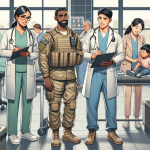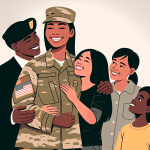Definition
Covering fire is a tactical military term defined as gunfire from weapons directed at enemy forces to protect, screen, or divert attention from friendly troops who are moving or conducting other operations. This type of fire is intended not necessarily to kill the enemy but to limit their ability to move or return fire. It serves as a defensive measure, often used during retreats, advances, or ambushes to ensure the safety of the troops.
Key Takeaways
- Covering fire refers to the use of suppressive fire, which is aimed at disrupting or halting enemy action. It does not necessarily aim to destroy the enemy, but to restrict their movement, action, or attention.
- It is a vital component in any military operation as it allows teams to maneuver, advance, or retreat without getting directly engaged with the enemy forces. It’s often used to protect soldiers who are exposed to enemy fire during such movements.
- The effective use of covering fire requires good communication, coordination, and timing between military units. The team providing the covering fire needs to shift or stop their fire once their allies have reached safety to avoid friendly fire.
Importance
Covering fire is a critical concept in military operations as it plays a vital role in promoting the safety and strategic movement of military personnel. It refers to the use of suppressive fire with an objective to distract, confuse, or hamper enemy forces rather than to kill them.
This allows friendly forces to move across battlegrounds or to retreat without substantial risk of enemy counterattacks. By employing covering fire, it limits the opponents’ ability to effectively engage, providing tactical advantages to advancing or retreating forces.
It significantly impacts strategic decision-making, directly influencing the outcomes of battles and ultimately, warfare. It exemplifies not only the combative prowess but also the protective and cooperative aspects of military engagement.
Therefore, covering fire is a key element in military maneuvers.
Explanation
Covering fire, at its core, is an imperative military operation that plays a crucial role in providing protection and ensuring the safety of the troops, particularly those on the move. The essence of covering fire is to suppress or distract the enemy’s vigilance, attack, or defense, which allows soldiers to advance, retreat, or reposition without suffering significant harm.
Usually provided by artillery or aerial forces, its purpose is geared toward controlling the enemy’s actions and creating opportunities for tactical maneuvers. For example, during the course of a battlefield engagement, a group of soldiers may need to cross a potentially dangerous open ground.
When they do, their team can employ covering fire towards the enemy positions to divert their attention and foil their attempts to target the moving group. It is, indeed, a crucial stratagem that can effectively impede the enemy’s sight, range, and capacity to react, hence providing the friendly forces a leveraged battlefield advantage.
This tactic can be crucial in certain scenarios such as rescuing injured personnel, retreating, or advancing against enemy lines.
Examples of Covering fire
Operation Overlord (D-Day): During World War II, the Allied Forces used covering fire extensively during the invasion of Normandy. Prior to the troops’ landing on the beach on June 6, 1944, naval and airborne artillery units gave a massive covering fire to suppress and confuse German defense forces. This bought time for the advancing infantry and armored forces to disembark onto the beach and start their assault with less direct enemy fire.
The Battle of Fallujah (2004): In the second battle of Fallujah, U.S. Marines extensively used covering fire in urban warfare against insurgency in Iraq. The use of machine guns, mortars, snipers, and armored vehicles didn’t just eliminate the enemy; it was also used strategically, to divert enemy’s attention or limit their movements, allowing for safe evacuation of injured personnel and civilian non-combatants.
Battle of Chosin Reservoir (1950): During the Korean War, the US military used covering fire to protect troops as they attempted a breakout from encirclement by Chinese forces. As the 30,000 UN troops fought their way 78 miles to the coast, constant covering fire was key to keep Chinese forces at bay, enabling their successful evacuation.
FAQs on Covering Fire
What is covering fire?
Covering fire is a tactical military concept where firepower is directed towards enemy positions with the intent of suppressing the enemy’s activity. It is not necessarily intended to kill, instead, its major purpose is to distract, confuse, and limit enemy forces.
What is the main goal of covering fire?
The main goal of covering fire is to restrict or inhibit the enemy’s freedom of action. It acts as a deterrent, preventing them from shooting, observing, or moving by keeping their heads down or forcing them to seek cover.
How does covering fire contribute to military operations?
Covering fire is an integral part of military operations. It facilitates movement, protects friendly troops, suppresses enemy defenses, and enables attack on enemy positions. It can also serve to confuse the enemy and reduce their operational effectiveness.
Can covering fire be used in defensive operations?
Yes, covering fire can be used in defensive operations. Patterned suppression of certain areas can deter enemy advancement and provide the opportunity for defensive troops to better position themselves or retreat if necessary.
Who provides covering fire during a military operation?
Covering fire can be provided by a variety of military assets. Typically, it can be supplied by infantry, armed vehicles, artillery, air support or naval gunfire, depending on the type of operation and the tactical situation.
Related Military Operation Terms
- Disability Compensation
- Pension Benefits
- Education & Training
- Vocational Rehabilitation & Employment
- Dependents’ Educational Assistance (DEA)
Sources for More Information
- Britannica Encyclopedia: This resource provides in-depth, reputable information across a multitude of topics including military operations and tactics such as covering fire.
- Military.com: This website has a wealth of information about the military, including in-depth articles on specific operations and strategies like covering fire.
- U.S. Naval Institute: The U.S. Naval Institute provides a comprehensive resource for naval information, which often includes notable military operation strategies.
- JSTOR: JSTOR is an online library with a large collection of academic articles. You may find scholarly papers on the military subject of covering fire.
 Benefits.com Advisors
Benefits.com Advisors
With expertise spanning local, state, and federal benefit programs, our team is dedicated to guiding individuals towards the perfect program tailored to their unique circumstances.
Rise to the top with Peak Benefits!
Join our Peak Benefits Newsletter for the latest news, resources, and offers on all things government benefits.




















